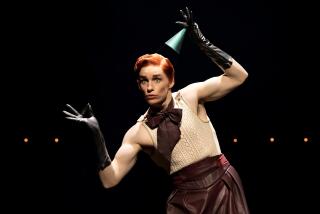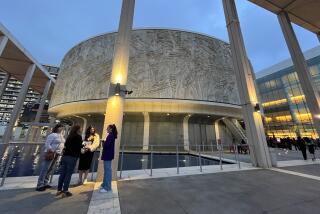Alice Tully Hall’s makeover resounds
At a time when the moneyed life in New York feels as if it is being sucked into the sewers, the reopening of Alice Tully Hall, the chamber music venue at Lincoln Center, feels like an eddy in the stream.
After the hall had been caged for almost two years by scaffolding and heavy equipment, the cranes and construction workers finally vanished last month, and a landmark was reborn.
The makeover of the concert hall and of the building that houses it and the Juilliard School is the first part of a $1-billion mission, led by the architecture firm of Diller Scofidio + Renfro, to rejuvenate all of Lincoln Center by 2011.
Tully alone cost $159 million. But now it has gun-metal gray seats and a state-of-the-art stage that thrusts into the audience; and swooping new balconies that, from below, resemble the fins of a 1958 Cadillac. And the front of the building on Broadway and 65th Street has a glass wall that offers unobstructed two-way views -- of both the live theater that is New York street life and the action in the lobby cafe that is open even when there aren’t performances.
“After months of bad news I feel like the city finally, finally gave me a little break by unveiling depressing old Alice Tully in a pretty new dress,” said Cecile Allon, a mezzo-soprano from St. Louis, who came to New York originally to study music.
Before the renovation, she used to attend Tully’s free Wednesday lunchtime concerts. Back then, the crowd was mostly retirees -- and a sprinkling of young musicians like the 24-year-old Allon. For the first Wednesday concert after the reopening, Allon showed up, but just for a quick espresso at the curvy bar in the lobby. She wanted to be part of the scene, but she also had to go to work at her part-time teaching job.
“Finally, finally,” she said, giggling. “A cool place for the uncool: struggling artists like me.”
It wasn’t just pent-up curiosity that packed Tully at that first concert.
Yes, it was free, and now that the city feels sometimes as empty as an Edward Hopper painting of a late-night diner, New Yorkers crave free.
At the same time, they seem primed for the kind of optimism inherent in the dreams of artists.
That first concert drew many more young people, and some who were middle-aged and worked irregular hours, and others who were no longer working at all. They savored the new-auditorium smells. A few whined about the new aisle steps being uneven, which they were by design. And the so-called experts -- because there is no “expert” like an amateur New Yorker -- looked forward to judging the acoustics. Would they now hear at Tully the kind of crystalline sounds they’d come to expect at Carnegie Hall?
Four groups of Juilliard students each performed Schubert. A young pianist played a 19th century parlor piece, in duet with his professor. A tenor, wearing a tie that matched the color of the moabi wood interior of the concert hall, stood practically at the edge of the stage, thrilling people in the first rows with his hand gestures as he sang about the waves on a lake. There was also a string quartet, and a finale by Moran Katz, a clarinetist from Israel, and Devon Guthrie, a young soprano from L.A.
In the past, the roar of subways that run under Broadway might have interfered with Guthrie’s voice when it dimmed, almost sotto voce. But as part of the renovation, the city agreed to silence the screeching by padding the tracks directly underground, and the sweet student voice was able to hold the crowd.
“I love the new acoustics,” said Herbert Levy, a 67-year-old retired lawyer from Queens.
A lot of his friends had moved to Florida after they retired, he explained during an interview after the concert. But not Levy. He spends his days at concerts and opera rehearsals, in theaters and museums. His favorite website is clubfreetime.com, because it lists every gratis cultural event in New York. Just give Levy an aisle seat, so he can stretch out his long legs, and an uninterrupted hour of Schubert, and he’s the happiest guy in New York.
For the most part, Levy’s enthusiasm for the modernized hall has been matched by professional architecture and music critics. Even the curmudgeonly Lee Rosenbaum, who groused about the acoustics and those pesky steps on her blog CultureGrrl, offered a few upbeat words: “The warm glow of the concert hall is dazzling.”
A focus on the arts
At this grim moment, it is, in fact, hard not to be unremittingly hopeful about a new public space for the arts.
For many, like Levy and Allon, to be able to drop by Lincoln Center, even for just an hour of uneven student performances of Schubert, embodies why they came in the first place to this city -- and why they remain.
They are drawn to the drama of striving for perfection. Some days that may involve colliding with ballerinas as they bound down Broadway in their sneakers on their way to rehearsal. (They’re easy to spot by their wide gaits and hair clenched into high buns.) Other days it may mean catching a snippet of conversation on the subway between two playwrights, recognizable by the scripts bundled under their coats.
Elizabeth Diller, the lead architect, seemed to be seeking that spontaneity of spirit through the redesign of Lincoln Center. She told reporters the week before the reopening that as the performing arts center had stood high on a plinth on the Upper West Side for the last 50 years, the multiple halls and theaters were “very much divorced from the fabric of the city. That’s what contributed to an elitist sense.” Her designs for new entrances and green spaces were intended “to embrace Lincoln Center as a hangout for New Yorkers.”
So now in front of Alice Tully Hall is a free-standing structure that looks like the prow of a ship. It is equipped with seats so people walking down Broadway can stop and perch awhile; they can look down into to the glassed-in lobby or up through the windows of the second-floor dance studio used by Juilliard.
In another part of town, there are many similar glass walls that allow passers-by to watch the bread-and-circus of morning television. It’s a pleasant surprise, for once, to linger over the ambitions of young dancers and be tempted into the realm of high culture.
As Lincoln Center’s President Reynold Levy said recently, referring to the impossible task before the renovation of finding the front entrance to the building: “Never again will anyone utter the question, ‘Where is Alice Tully Hall?’ ”
More to Read
The biggest entertainment stories
Get our big stories about Hollywood, film, television, music, arts, culture and more right in your inbox as soon as they publish.
You may occasionally receive promotional content from the Los Angeles Times.






